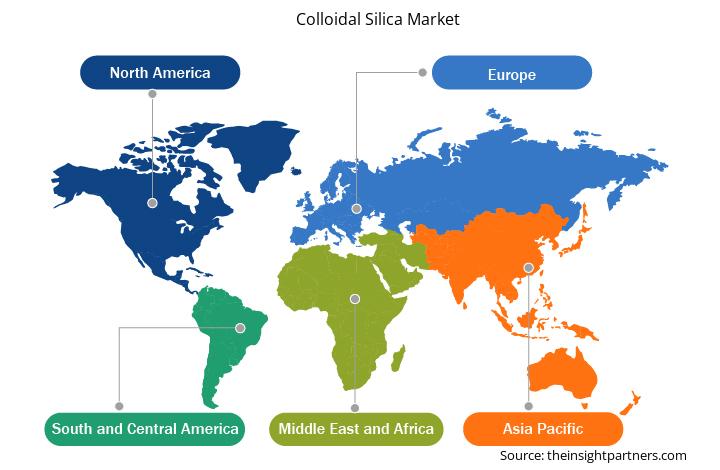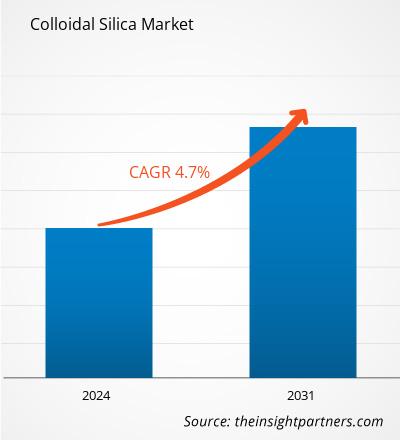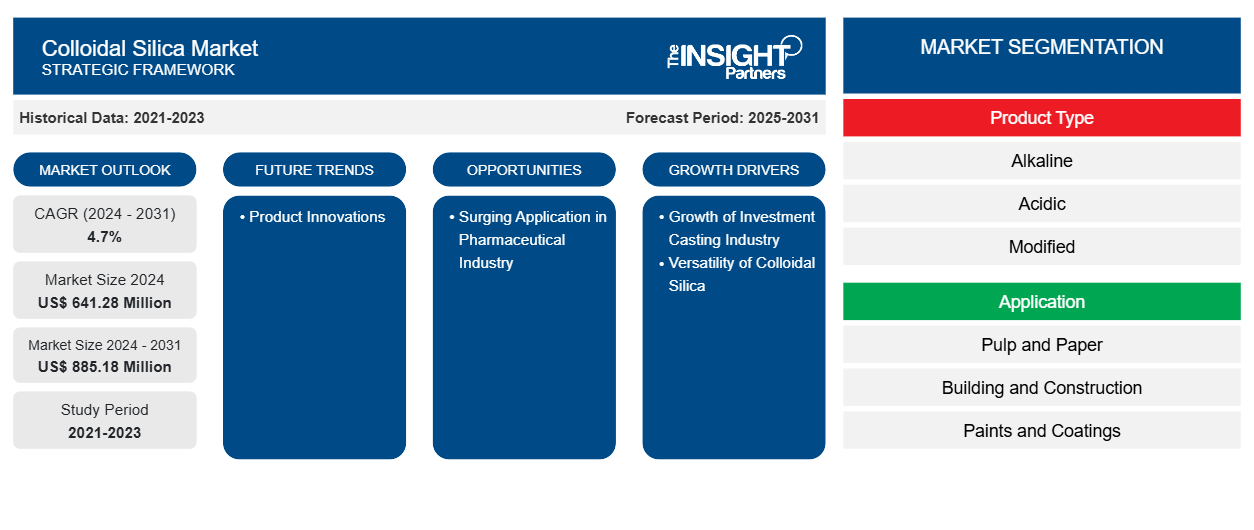Der Markt für kolloidale Kieselsäure soll von 641,28 Millionen US-Dollar im Jahr 2024 auf 885,18 Millionen US-Dollar im Jahr 2031 anwachsen; für den Zeitraum 2024–2031 wird ein durchschnittliches jährliches Wachstum von 4,7 % erwartet. Die neuen Produktinnovationen werden voraussichtlich neue Trends auf dem Markt einführen.
Kolloidale Kieselsäure Marktanalyse
Feinguss (auch bekannt als Wachsausschmelzverfahren oder Präzisionsguss) ist eines der ältesten Metallformungsverfahren. Es wird verwendet, um komplexe Gussteile, nahezu fertige Endformen und verschiedene Materialien herzustellen. Bei diesem Verfahren wird ein Wachsmodell verwendet, um eine Einweg-Keramikform zu formen. Ein Wachsmodell, das genau der Form des zu gießenden Objekts entspricht, wird mit einem feuerfesten Keramikmaterial beschichtet. Kolloidale Kieselsäure ist ein beliebtes Bindemittel in der Präzisionsfeingussindustrie, da es als sichere, wirtschaftliche und einfach zu verwendende Schlammkomponente dient, die sich gut als Primär- oder Backup-Schlamm eignet. Diese Form von Kieselsäure ist sehr stabil und bildet aufgrund der chemischen Inertheit des Bindemittels einen langlebigen Keramikschlamm mit einer breiten Palette feuerfester Materialien. Die Entwicklung neuartiger Feingussanwendungen aufgrund kontinuierlicher Innovationen auf diesem Gebiet treibt den Fortschritt des Marktes für kolloidale Kieselsäure voran .
Marktübersicht für kolloidale Kieselsäure
Der Markt für kolloidale Kieselsäure verzeichnet ein starkes Wachstum, das durch die vielfältigen Anwendungsmöglichkeiten in verschiedenen Branchen vorangetrieben wird. Kolloidale Kieselsäure, ein feines, in Flüssigkeit suspendiertes Siliziumdioxidpartikel, wird aufgrund seiner einzigartigen Eigenschaften wie hoher Reinheit, Dispergierbarkeit und Stabilität häufig in Branchen wie der Automobil-, Elektronik-, Chemie- und Kosmetikindustrie eingesetzt. In der Automobilindustrie ist kolloidale Kieselsäure für die Herstellung von Hochleistungslacken, -beschichtungen und -klebstoffen unverzichtbar , während sie in der Elektronikindustrie bei der Herstellung von Halbleitern und Mikroelektronik eingesetzt wird. Die steigende Nachfrage nach fortschrittlichen Technologien und Hochleistungsmaterialien sowie die zunehmende Anwendung kolloidaler Kieselsäure in der Wasseraufbereitung und als Katalysatorträger treiben das Marktwachstum weiter voran.
Passen Sie diesen Bericht Ihren Anforderungen an
Sie erhalten kostenlos individuelle Anpassungen an jedem Bericht, einschließlich Teilen dieses Berichts oder einer Analyse auf Länderebene, eines Excel-Datenpakets sowie tolle Angebote und Rabatte für Start-ups und Universitäten.
-
Holen Sie sich die wichtigsten Markttrends aus diesem Bericht.Dieses KOSTENLOSE Beispiel umfasst eine Datenanalyse von Markttrends bis hin zu Schätzungen und Prognosen.
Treiber und Chancen auf dem Markt für kolloidale Kieselsäure
Vielseitigkeit von kolloidaler Kieselsäure fördert Marktwachstum
Von der Verbesserung der Sauerstoffbarriereeigenschaften bis zur Verbesserung der Tintenabsorption spielt kolloidale Kieselsäure in Herstellungsprozessen verschiedene Rollen. Es ist ein äußerst vielseitiges Material, das die Eigenschaften vieler Produkte verbessern kann, die in Branchen wie dem Bauwesen sowie der Lebensmittel- und Getränkeindustrie verwendet werden. Darüber hinaus wird kolloidale Kieselsäure in der Elektronikindustrie häufig als Poliermittel verwendet, um eine saubere Oberfläche in Halbleiterscheiben zu erzeugen. Es haftet gut über Wasserstoff- und Ionenbindungen an vielen Oberflächen und erleichtert so Anwendungen zur Oberflächenmodifizierung. Sobald sie auf eine Oberfläche aufgetragen werden, erhöhen Kieselsäurepartikel den Reibungskoeffizienten, was für Industrie- und Baubeschichtungen, Polierschlämme, Fußböden sowie Papier und Karton nützlich ist. Diese Bindungen sind chemisch inert und thermisch stabil, was sie besonders nützlich für Isolierplatten, Katalysatoren, Spezialbeschichtungen, vakuumgeformte Feuerfestmaterialien und Feingussschlämme macht.
Kolloidale Kieselsäuresorten mit größeren Partikelgrößen sind als Oberflächenmodifikatoren wirksamer, während kleinere Partikel als Bindemittel besser geeignet sind. Andere Faktoren wie der ionische Charakter und der pH-Wert der Endformulierung helfen bei der Bestimmung der erforderlichen Eigenschaften kolloidaler Kieselsäure. Daher hat die Vielseitigkeit kolloidaler Kieselsäure eine konstante Nachfrage nach diesem Material in verschiedenen Endverbrauchsbranchen sichergestellt und damit das Marktwachstum vorangetrieben.
Steigende Anwendungsintensität in der Pharmaindustrie schafft Wachstumschancen
Kolloidale Kieselsäure dient als vielseitiger Hilfsstoff in pharmazeutischen Formulierungen und spielt eine entscheidende Rolle bei der Verbesserung der Produktstabilität, der Fließfähigkeit und der Kontrolle von Freisetzungsprofilen. Die steigende Verbreitung chronischer Krankheiten in Verbindung mit einer alternden Weltbevölkerung treibt das Wachstum der Pharmaindustrie weltweit voran. Steigende verfügbare Einkommen und Regierungspolitiken treiben das Wachstum dieser Branchen ebenfalls an. Laut den Daten der HSBC Bank zielt die Initiative „Healthy China 2030“ darauf ab, die Größe der Gesundheitsdienstleistungsbranche des Landes bis 2030 auf ca. 2,4 Billionen US-Dollar zu steigern. Darüber hinaus floriert der Gesundheitsmarkt in Indien mit dem Aufstieg des Landes zu einem neuen Gesundheitszentrum aufgrund höherer Ausgaben für das private und öffentliche Gesundheitswesen, boomender pharmazeutischer Produktions- und Dienstleistungskapazitäten und eines sich entwickelnden Ökosystems für Gesundheitstechnologie.
Da die Pharmaindustrie bestrebt ist, Innovationen zu entwickeln und neue Arzneimittelverabreichungssysteme zu entwickeln, wird auch die Nachfrage nach kolloidaler Kieselsäure in den kommenden Jahren weiter steigen. Bedeutende Fortschritte in der Arzneimittelverabreichungstechnologie, einschließlich Formulierungen mit kontrollierter Freisetzung und gezielten Arzneimittelverabreichungssystemen, erfordern häufig auf bestimmte Eigenschaften zugeschnittene Hilfsstoffe. Die einzigartigen Eigenschaften von kolloidaler Kieselsäure – insbesondere die große Oberfläche und die kontrollierte Partikelgröße – machen sie zu einem idealen Kandidaten für diese fortschrittlichen Arzneimittelverabreichungssysteme. Daher unterstützt die wachsende Nachfrage nach Medikamentenpillen in Verbindung mit verschiedenen staatlichen Initiativen für die öffentliche Gesundheit das Wachstum des Marktes für kolloidale Kieselsäure.
Segmentierungsanalyse des Marktberichts über kolloidale Kieselsäure
Wichtige Segmente, die zur Ableitung der Marktanalyse für kolloidale Kieselsäure beigetragen haben, sind Produkttyp und Anwendung.
- Basierend auf dem Produkttyp ist der Markt für kolloidale Kieselsäure in alkalisch, sauer, modifiziert und gewöhnlich unterteilt.
- Nach Anwendung ist der Markt segmentiert in Zellstoff und Papier, Bauwesen, Farben und Lacke , Elektronik und Halbleiter, Pharmazeutika, Feinguss, Kosmetik, Haushaltsprodukte und Sonstiges. Das Segment Farben und Lacke ist weiter segmentiert in Metallbeschichtungen, Keramikbeschichtungen und Sonstiges.
Kolloidale Kieselsäure – Marktanteilsanalyse nach Geografie
Der geografische Umfang des Marktberichts für kolloidale Kieselsäure ist hauptsächlich in fünf Regionen unterteilt: Nordamerika, Asien-Pazifik, Europa, Naher Osten und Afrika sowie Süd- und Mittelamerika.
Der asiatisch-pazifische Raum wird voraussichtlich im Prognosezeitraum den Markt dominieren. Der asiatisch-pazifische Raum ist weltweit als wichtiger Standort für die Herstellung von Halbleitern bekannt. Die Halbleiterindustrie boomt in Asien-Pazifik weiterhin, da die Nachfrage nach Unterhaltungselektronik anhält. Mehrere Länder in der Region sind wichtige Förderer der Halbleiterindustrie in der Welt. Taiwan ist beispielsweise nach Umsatz die zweitgrößte Chipwirtschaft der Welt. Darüber hinaus wird erwartet, dass trotz einiger Abschwünge in der Branche Automobilanwendungen die Investitionsausgaben in der Halbleiterindustrie im asiatisch-pazifischen Raum ankurbeln werden. Die Nachfrage nach Halbleitern wächst stetig. Der Nachfrageschub im Jahr 2020 führte im Gegensatz zu einer Produktionspause während der COVID-19-Krise zu einem Mangel an Halbleitern. Um Rückstände abzubauen, planten daher viele Hersteller in der Region, die Produktion zu steigern, was dem Markt für kolloidale Kieselsäure zugute kommen dürfte.
Kolloidale Kieselsäure (Kieselsol) wird auch in Branchen wie der Textil-, Papier-, Beschichtungs-, Feuerfest- und Keramikindustrie sowie in Gießereien verwendet. Die Automobilindustrie treibt den Markt für kolloidale Kieselsäure im asiatisch-pazifischen Raum maßgeblich an. Da die Region weiterhin einen Anstieg der Automobilproduktion und -verkäufe erlebt, steigt die Nachfrage nach Fahrzeugkomponenten. Laut OICA stieg die Fahrzeugproduktion in Asien-Ozeanien von 50 Millionen im Jahr 2022 auf 55,1 Millionen im Jahr 2023. Die schnelle Einführung von Elektrofahrzeugen in der Region treibt also die Nachfrage nach Hochleistungsautoteilen an und treibt damit den Markt in Richtung Wachstum.
Regionale Einblicke in den Markt für kolloidale Kieselsäure
Die regionalen Trends und Faktoren, die den Markt für kolloidale Kieselsäure während des gesamten Prognosezeitraums beeinflussen, wurden von den Analysten von Insight Partners ausführlich erläutert. In diesem Abschnitt werden auch die Marktsegmente und die Geografie für kolloidale Kieselsäure in Nordamerika, Europa, im asiatisch-pazifischen Raum, im Nahen Osten und Afrika sowie in Süd- und Mittelamerika erörtert.

- Erhalten Sie regionalspezifische Daten zum Markt für kolloidale Kieselsäure
Umfang des Marktberichts über kolloidale Kieselsäure
| Berichtsattribut | Details |
|---|---|
| Marktgröße im Jahr 2024 | 641,28 Millionen US-Dollar |
| Marktgröße bis 2031 | 885,18 Millionen US-Dollar |
| Globale CAGR (2024 - 2031) | 4,7 % |
| Historische Daten | 2021-2023 |
| Prognosezeitraum | 2025–2031 |
| Abgedeckte Segmente |
Nach Produkttyp
|
| Abgedeckte Regionen und Länder |
Nordamerika
|
| Marktführer und wichtige Unternehmensprofile |
|
Dichte der Marktteilnehmer für kolloidale Kieselsäure: Deren Auswirkungen auf die Geschäftsdynamik verstehen
Der Markt für kolloidale Kieselsäure wächst rasant, angetrieben durch die steigende Nachfrage der Endverbraucher aufgrund von Faktoren wie sich entwickelnden Verbraucherpräferenzen, technologischen Fortschritten und einem größeren Bewusstsein für die Vorteile des Produkts. Mit steigender Nachfrage erweitern Unternehmen ihr Angebot, entwickeln Innovationen, um die Bedürfnisse der Verbraucher zu erfüllen, und nutzen neue Trends, was das Marktwachstum weiter ankurbelt.
Die Marktteilnehmerdichte bezieht sich auf die Verteilung der Firmen oder Unternehmen, die in einem bestimmten Markt oder einer bestimmten Branche tätig sind. Sie gibt an, wie viele Wettbewerber (Marktteilnehmer) in einem bestimmten Marktraum im Verhältnis zu seiner Größe oder seinem gesamten Marktwert präsent sind.
Die wichtigsten auf dem Markt für kolloidale Kieselsäure tätigen Unternehmen sind:
- Cabot Corp
- Evonik Industries AG
- Merck KGaA
- Ecolab Inc
- Nouryon Chemicals Holding BV
- WR Grace & Co
Haftungsausschluss : Die oben aufgeführten Unternehmen sind nicht in einer bestimmten Reihenfolge aufgeführt.

- Überblick über die wichtigsten Akteure auf dem Markt für kolloidale Kieselsäure
Neuigkeiten und aktuelle Entwicklungen zum Markt für kolloidale Kieselsäure
Der Markt für kolloidale Kieselsäure wird durch die Erhebung qualitativer und quantitativer Daten aus Primär- und Sekundärforschung bewertet, die wichtige Unternehmensveröffentlichungen, Verbandsdaten und Datenbanken umfasst. Nachfolgend sind einige der Entwicklungen auf dem Markt aufgeführt:
- Evonik Industries AG hat in seiner neuen Anlage in Weston, Michigan, mit der Produktion von hochreiner kolloidaler Kieselsäure für die Halbleiterindustrie begonnen. Die neue Anlage ist eine strategische Ergänzung des Portfolios von Evonik und ein Beweis für sein Engagement, seinen Kunden im Halbleitermarkt Innovation und Versorgungssicherheit zu bieten. (Evonik, Unternehmenswebsite, 2024)
- Nouryon Chemicals Holding BV hat die Erweiterung seiner Produktionskapazität für kolloidale Kieselsäure Levasil um fast 50 % in seiner Produktionsanlage in Green Bay, Wisconsin, USA, abgeschlossen. Mit dieser Ausweitung reagiert das Unternehmen auf die steigende Nachfrage nach kolloidaler Kieselsäure, insbesondere in Nordamerika, und kann so seine globale Produktionspräsenz für kolloidale Kieselsäure strategisch erweitern, um regionale und internationale Kunden zu bedienen. (Nouryon Chemicals Holding BV, Unternehmenswebsite, 2024)
- Evonik Industries AG hat an seinem Standort in Weston, Michigan, USA, eine neue Anlage zur Herstellung von hochreiner kolloidaler Kieselsäure errichtet. Mit dieser neuen Anlage soll das Unternehmen zu einem der einzigen Akteure auf dem Markt werden, der die für die chemisch-mechanische Planarisierung (CMP), einen Prozessschritt in der Mikrochip-Herstellung, benötigte kolloidale Kieselsäure zuverlässig in der erforderlichen Qualität und Reinheit produzieren kann. (Evonik, Unternehmenswebsite, 2023)
- AMS Applied Material Solutions hat einen vielschichtigen Plan zur Ausweitung seiner Geschäftstätigkeit in Singapur bis 2030 angekündigt. Der Plan zielt darauf ab, die globalen Fertigungs- und F&E-Kapazitäten des Unternehmens zu stärken, die Partnerschaften im Technologie-Ökosystem in Singapur auszubauen und die Entwicklung der lokalen Belegschaft zu fördern. (AMS Applied Material Solutions, Unternehmenswebsite, 2022)
Marktbericht zu kolloidaler Kieselsäure – Umfang und Ergebnisse
Der Bericht „Marktgröße und Prognose für kolloidale Kieselsäure (2021–2031)“ bietet eine detaillierte Analyse des Marktes, die die folgenden Bereiche abdeckt:
- Kolloidale Kieselsäure Marktgröße und Prognose für alle wichtigen Marktsegmente im Rahmen des Geltungsbereichs
- Markttrends für kolloidale Kieselsäure sowie Marktdynamik wie Treiber, Einschränkungen und wichtige Chancen
- Detaillierte Porter's Five Forces und SWOT-Analyse
- Marktanalyse für kolloidale Kieselsäure, die wichtige Markttrends, länderspezifische Rahmenbedingungen, wichtige Akteure, Vorschriften und aktuelle Marktentwicklungen umfasst.
- Branchenlandschaft und Wettbewerbsanalyse, einschließlich Marktkonzentration, Heatmap-Analyse, prominenten Akteuren und aktuellen Entwicklungen auf dem Markt
- Detaillierte Firmenprofile
- Historische Analyse (2 Jahre), Basisjahr, Prognose (7 Jahre) mit CAGR
- PEST- und SWOT-Analyse
- Marktgröße Wert/Volumen – Global, Regional, Land
- Branchen- und Wettbewerbslandschaft
- Excel-Datensatz
Aktuelle Berichte
Erfahrungsberichte
Grund zum Kauf
- Fundierte Entscheidungsfindung
- Marktdynamik verstehen
- Wettbewerbsanalyse
- Kundeneinblicke
- Marktprognosen
- Risikominimierung
- Strategische Planung
- Investitionsbegründung
- Identifizierung neuer Märkte
- Verbesserung von Marketingstrategien
- Steigerung der Betriebseffizienz
- Anpassung an regulatorische Trends























 Kostenlose Probe anfordern für - Markt für kolloidale Kieselsäure
Kostenlose Probe anfordern für - Markt für kolloidale Kieselsäure